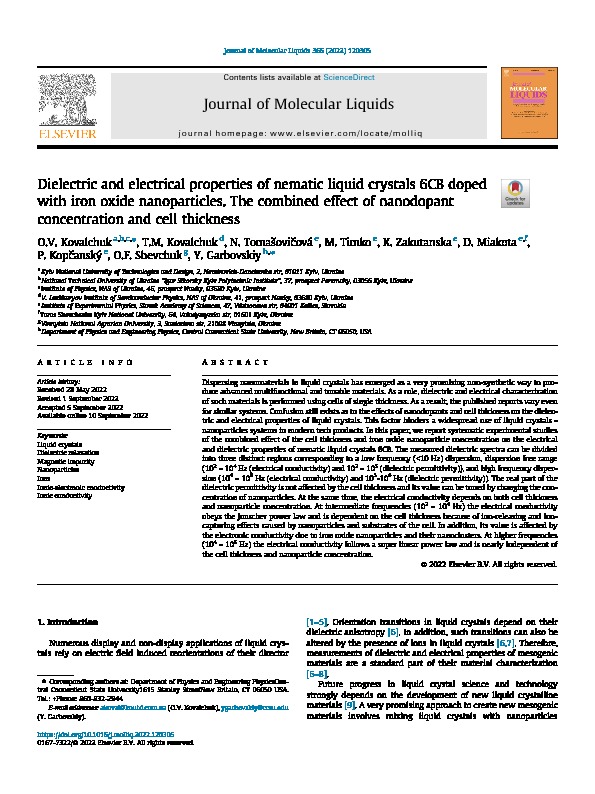id: 31524
Title: Dielectric and electrical properties of nematic liquid crystals 6CB doped with iron oxide nanoparticles.The combined effect of nanodopant concentration and cell thickness
Authors: Kovalchuk O.V., Kovalchuk T.M., Tomašovičová N., Timko M., Zakutanska K., Miakota D., Kopčanský P., Shevchuk O.F., Garbovskiy Y
Keywords: liquid crystals, dielectric relaxation, magnetic impurity, nanoparticles Ions, Ionic-electronic conductivity, Ionic conductivity.
Date of publication: 2022-09-28 20:55:47
Last changes: 2022-09-28 20:55:47
Year of publication: 2022
Summary: Dispersing nanomaterials in liquid crystals has emerged as a very promising non-synthetic way to produce advanced multifunctional and tunable materials. As a rule, dielectric and electrical characterization of such materials is performed using cells of single thickness. As a result, the published reports vary even for similar systems. Confusion still exists as to the effects of nanodopants and cell thickness on the dielectric and electrical properties of liquid crystals. This factor hinders a widespread use of liquid crystals - nanoparticles systems in modern tech products. In this paper, we report systematic experimental studies of the combined effect of the cell thickness and iron oxide nanoparticle concentration on the electrical and dielectric properties of nematic liquid crystals 6CB. The measured dielectric spectra can be divided into three distinct regions corresponding to a low frequency (<10 Hz) dispersion, dispersion free range (102 – 104 Hz (electrical conductivity) and 102 – 105 (dielectric permittivity)), and high frequency dispersion (104 – 106 Hz (electrical conductivity) and 105-106 Hz (dielectric permittivity)). The real part of the dielectric permittivity is not affected by the cell thickness and its value can be tuned by changing the concentration of nanoparticles. At the same time, the electrical conductivity depends on both cell thickness and nanoparticle concentration. At intermediate frequencies (102 – 104 Hz) the electrical conductivity obeys the Jonscher power law and is dependent on the cell thickness because of ion-releasing and ioncapturing effects caused by nanoparticles and substrates of the cell. In addition, its value is affected by the electronic conductivity due to iron oxide nanoparticles and their nanoclusters. At higher frequencies (104 – 106 Hz) the electrical conductivity follows a super linear power law and is nearly independent of the cell thickness and nanoparticle concentration.
URI: http://socrates.vsau.edu.ua/repository/getfile.php/31524.pdf
Publication type: Статті Scopus/Web of Science
Publication: Journal of Molecular Liquids. 2022. Vol. 366 (15). № 120305.
In the collections :
Published by: Адміністратор
File : 31524.pdf Size : 1657300 byte Format : Adobe PDF Access : For all

| |
|
|